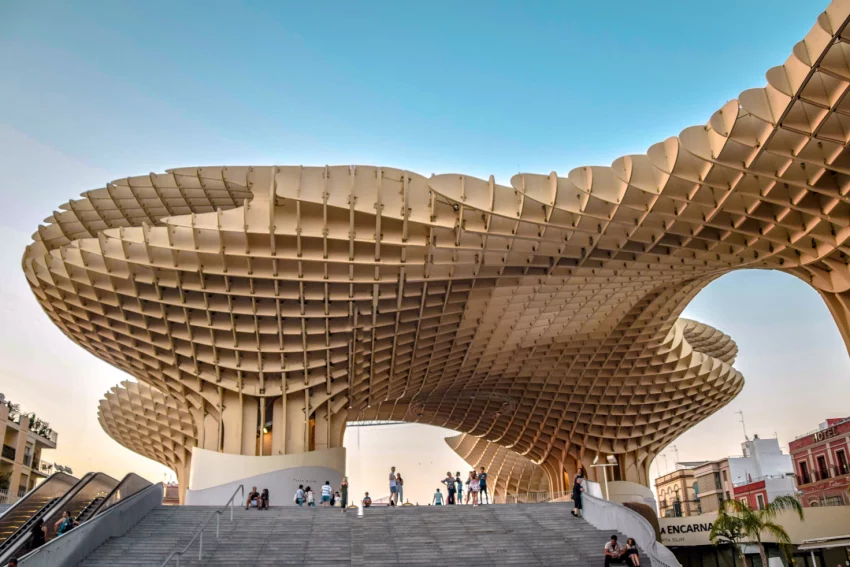Seville became my favourite city in Spain! It’s the vibrant capital of Andalucía, unquestionably stands out as one of the region’s most enchanting cities. With its compact size, basking in radiant sunshine (earning the title of Europe’s 2nd hottest city), and adorned with charming architecture, it’s the ideal destination for a delightful 4-day city break.
If you are planning to stay longer then I would recommend to read Unforgettable 5 Days in Seville – Perfect Seville Itinerary.
Strolling through its picturesque cobbled streets, you can swiftly immerse yourself in the city’s lively rhythm, even with a short timeframe. This 4-day Seville itinerary offers comprehensive information, covering what to explore in Seville, where to stay, and how to navigate this captivating city.
We flew to Seville from Brussels. But as far as I know many people also take a train to visit the city. The choice is yours just book your tickets well in advance to safe some costs.
How many days do you need in Seville?
For the best Seville experience, I would recommend to spend at least 4 days in Seville. This timeframe will allow you to delve into Seville’s rich history, wander through its charming streets, and appreciate iconic landmarks at a leisurely pace. With 4 days, there’s ample opportunity to savor the city’s fantastic food, witness captivating flamenco performances, and soak in the lively atmosphere along the picturesque Guadalquivir River. Believe me, you will fall in love with the city!
How to get around Seville?
Getting around Seville is a delightful experience, thanks to its walkable layout that allows visitors to explore many attractions on foot. The city’s compact size makes strolling through its charming streets an excellent way to discover hidden gems, historical sites, and vibrant neighborhoods.
Additionally, Seville offers a well-connected public transportation system, including buses and trams, for those looking to cover longer distances or venture to specific areas. For added convenience, rideshare services like Uber are also available, providing an efficient and comfortable option for getting around the city.
Where to stay in Seville?
- Historic City Center: For those who want to be in the heart of the action, staying in the historic city center is a must. Here, you’ll find charming boutique hotels housed in centuries-old buildings, offering easy access to top attractions like the Seville Cathedral, Alcazar Palace, and Barrio Santa Cruz.
- Triana Neighborhood: Across the Guadalquivir River lies the lively neighborhood of Triana, known for its flamenco music, ceramic workshops, and vibrant nightlife.
- Alameda de Hércules: If you’re looking for a more bohemian atmosphere, head to the Alameda de Hércules area. This hip neighborhood is filled with trendy bars, art galleries, and street markets. Choose from boutique hotels or stylish apartments for a unique and eclectic stay.
- Macarena District: For a quieter and more residential vibe, consider staying in the Macarena district. Here, you’ll find quaint guesthouses and budget-friendly accommodations, as well as easy access to lesser-known attractions like the Basilica de la Macarena and the Andalusian Parliament.
- Santa Justa Area: Traveling by train? The Santa Justa area, located near Seville’s main train station, is a convenient option for travelers arriving or departing by rail. You’ll find a range of hotels, from budget to upscale, as well as easy access to public transportation for exploring the rest of the city.
10 Best Things To See In Seville
- Real Alcázar
- Cathedral of Seville & La Giralda
- Plaza de España
- Parque de María Luisa
- Barrio Santa Cruz
- Tapas Tour
- Torre del Oro (the Gold Tower)
- The Metropol Parasol (Las Setas)
- Triana
- AIRE Ancient baths
- Flamenco Show
What to see in Seville in 4 days?
Seville itinerary – Day 1
Tip: by a combo ticket online so you can visit all these beautiful places.
Explore Seville by Bike
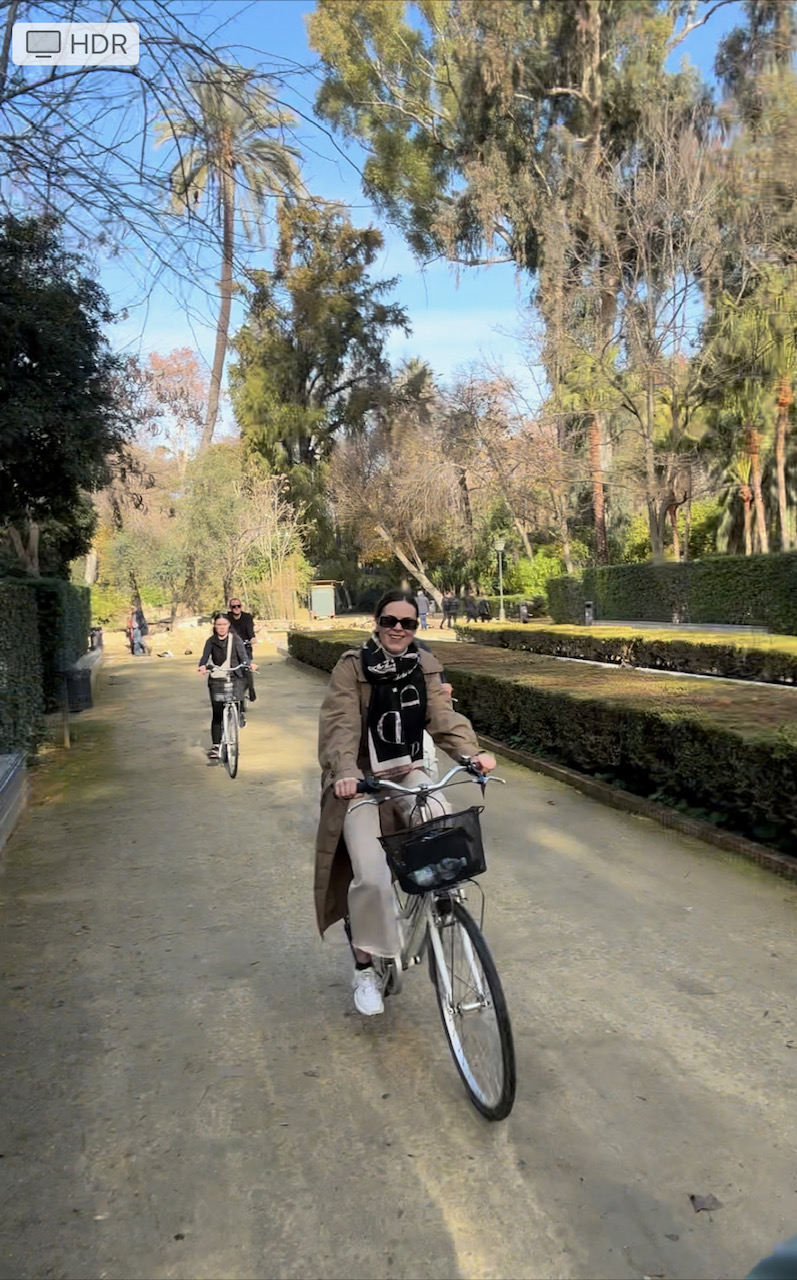

The best way to get to know new city when you spend 4 days in Seville, Spain is definitely by bike! Why so? It provides to quickly familiarize yourself with the layout of the city. In the early stages of your trip, cruising through Seville’s neighborhoods on a bike provides a sense of orientation and a chance to discover hidden gems and local spots. Moreover what makes the experience special is the city’s commitment to becoming one of Europe’s most bike-friendly destinations, boasting extensive bike lanes and a flat terrain that makes cycling a breeze.
We decided to book a bike tour with See By Bike and it was a great choice! Our tour guide Marta told us so many interesting facts about Seville, showed the most interesting neighbourhoods and even gave us tips what to visit next and where we can find the best tapas. This bike adventure doubtlessly not only provides a unique perspective of Seville’s historic landmarks, such as the iconic Giralda tower and the beautiful Plaza de España, but it also allowed us to effortlessly navigate the narrow, charming streets of the Old Town. So you feel like a local!
Brunch at Billy Brunch

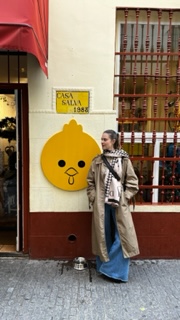

On my 4 day trip to Seville I stumbled upon a gem – Billy Brunch, and even went twice for a leisurely and delicious brunch. What makes this place stand out, especially if you’re traveling with kids, is the thoughtful addition of a kids’ corner filled with toys and books. It creates a relaxed environment where families can enjoy their meals without any fuss. The staff at Billy Brunch is incredibly friendly, adding a welcoming touch to the overall experience.
Now, let’s talk about the food – for those who prefer savory delights, I highly recommend the avocado toast with poached egg and salmon or the flavorful shakshuka. And here’s the kicker: their coffee is personalized with funny drawings! On my visit, I got a coffee with a cat. But let me tell you more about the pancakes – oh, they’re an absolute delight! Topped generously with dulce de leche, they’re a sweet revelation that keeps me coming back for more.
If you’re in Seville and craving a brunch that’s both tasty and family-friendly, I highly recommend checking out Billy Brunch – it’s a true hidden treasure!
La Giralda & Cathedral
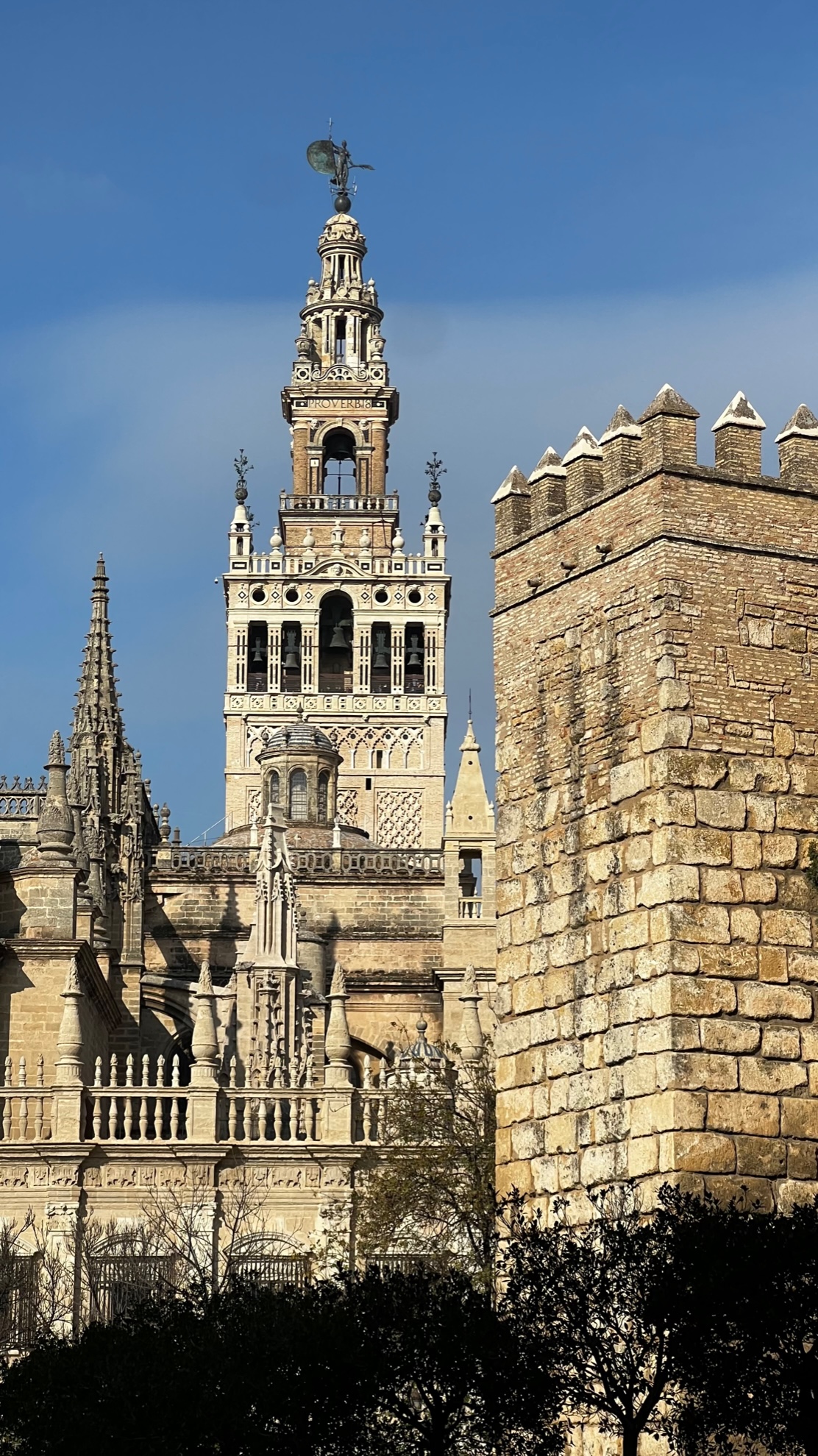
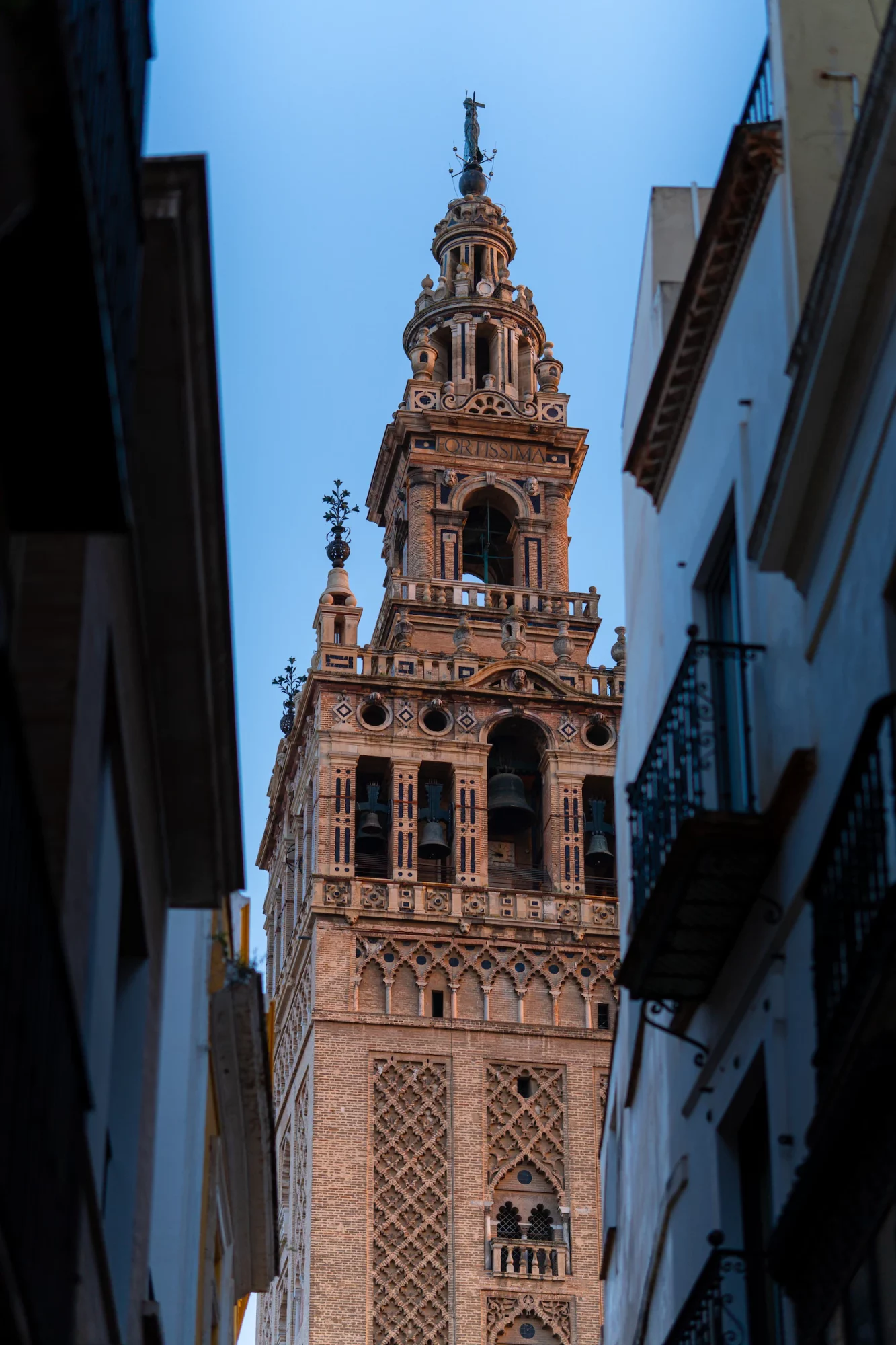
It’s a very famous landmark in Seville and there are very long queues during the high season (from late March to early June, from September to early November, December to first week of January), I recommend to book tickets online and choose particular time slot.
Start a captivating 4-day itinerary in Seville with historical exploration in the heart of the city. Day one begins with a visit of the Seville Cathedral and La Giralda Tower. You can’t possibly overlook this commanding structure, making it a must-visit on your Sevilla itinerary. It holds the prestigious title of a UNESCO World Heritage site, earning its rightful place on your Seville bucket list. In my opinion it’s the most beautiful and tremendous Cathedral that I’ve even seen!
As one of the largest Gothic cathedrals globally, it also serves as the final resting place of Christopher Columbus. With historical roots tracing back to a former mosque on this site, the cathedral emerged after the Christian conquest of Seville in 1248, replacing the mosque. Construction of this Gothic-style Roman Catholic marvel concluded in 1506.
Upon marveling at the Seville Cathedral, ascend the winding ramps of the 35-floor bell tower, known as the Giralda. Originally a minaret of the old mosque, these ramps were once used for horses carrying muezzins to the top. I would be honest the view on the top is not best since it’s packed with tourists and there are fences. But on the way to the top there are windows with beautiful views over the city!
Alcazar
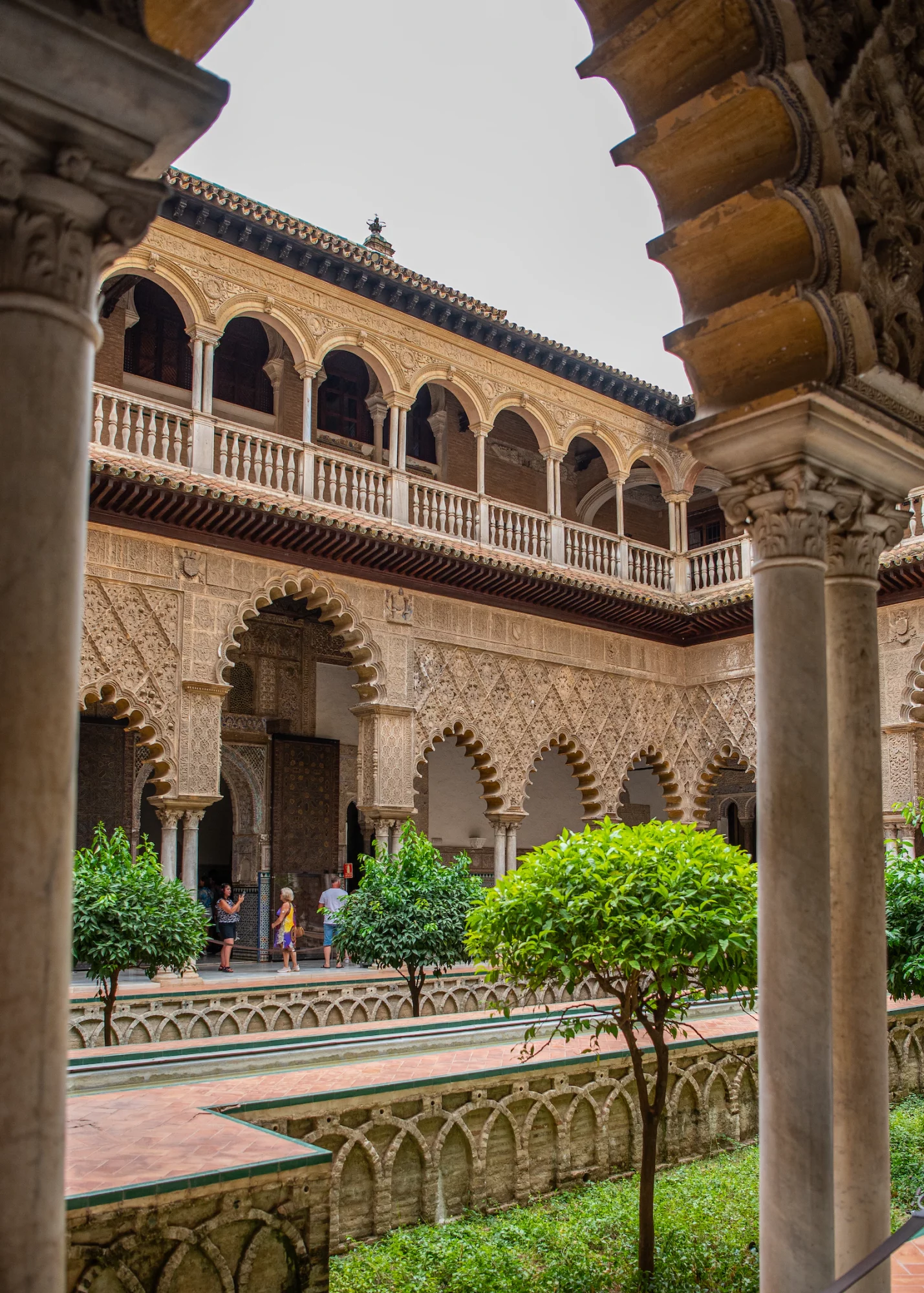
It’s a very famous landmark in Seville and there are very long queues during the high season (from late March to early June, from September to early November, December to first week of January), I recommend to book tickets online and choose particular time slot.
Continue with a visit to the renowned Real Alcázar, a must-see on any Seville itinerary. Originally constructed as a fort during Arabic rule, the palace evolved under Christian influence, ultimately becoming the residence of Spanish Kings who left their indelible marks on its design. In 1987, the Real Alcázar gained well-deserved recognition as a UNESCO World Heritage site. The Mudéjar architectural style, blending Moorish and Christian elements, creates a mesmerizing ambiance, reminiscent of the Nasrid Palaces in Granada. As you wander through the courtyards adorned with intricate lattice-like structures and ornate pillars, the beauty of the Courtyard of the Maidens, Mudéjar Palacio de Don Pedro, Salon de los Tapices, and Salon de Embajadores unfolds, offering a rich tapestry of history and design.
Dinner in the Old Jewish quarter
Just next to all these marvellous buildings you will find the Old Jewish Quarter, also known as Santa Cruz. It is renowned for its atmospheric ambiance, with vibrant squares and hidden patios providing the perfect backdrop for an evening meal. Definitely explore the narrow cobblestone streets and discover quaint restaurants tucked away in historic buildings.
In the Old Jewish Quarter you can Indulge in traditional Andalusian flavors with a modern twist, as many restaurants in this area showcase the rich culinary heritage of Seville. From tapas to exquisite local dishes, the Old Jewish Quarter offers a diverse gastronomic journey. And you will be surprised how low the prices are!
Seville itinerary – Day 2
Plaza de Espana
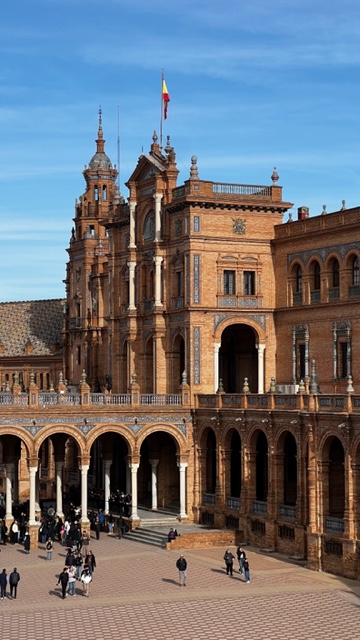
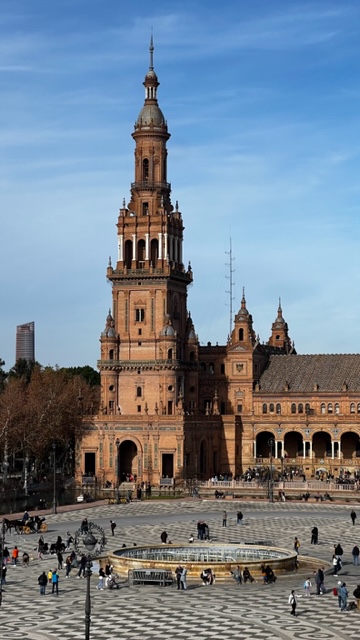
If you’re searching for ‘attractions in Seville, Spain,’ rest assured that this image will undoubtedly claim the top spot. And this place is just unbelievable! The magnificent Plaza de España, constructed for the 1929 Ibero-American Exposition, seamlessly blends Renaissance and Moorish architectural styles.
Plaza de España is undoubtedly one of the most stunning places to include in your 4-day itinerary in Seville. Make sure to visit this beautiful spot. This large, circular area features a charming fountain at it’s center. Keep an eye out for street performers who often add to the lively atmosphere. Find the perfect spot, and you might even feel the refreshing mist from the fountain, a welcome relief on a hot afternoon.
All around the circle, there are nice buildings with tall towers and balconies. You can go up some stairs to get a really good view of everything. The buildings have colorful tiles that show different parts of Spain. There’s also a big water trench next to the buildings with colorful bridges. You can even rent a little boat to paddle around in the water, although you won’t go very far. This iconic square is a must-see, offering both architectural beauty and a delightful experience for visitors in Seville.
Parque de Maria Luisa
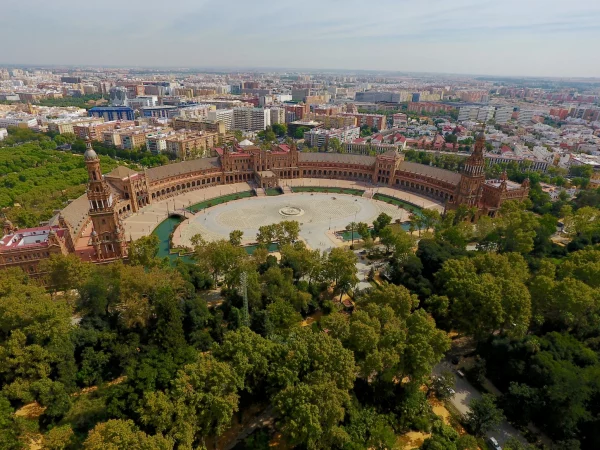
After exploring Plaza de España, venture into the beautiful Parque de María Luisa right next to it. This expansive park spans about 100 acres, featuring charming gazebos, serene lakes, graceful fountains, museums, and an array of tropical trees and flora. Wander through the intricate network of pathways, discovering hidden corners with inviting benches, all beneath the cooling shade of the canopy.
As you stroll, you’ll likely encounter the lively yet endearing green parrots, their cheerful squawks filling the air as they gracefully soar above. The park offers an ideal setting to unwind and relax on your final afternoon in Seville, providing a peaceful retreat surrounded by nature’s beauty.
Las Setas de Sevilla

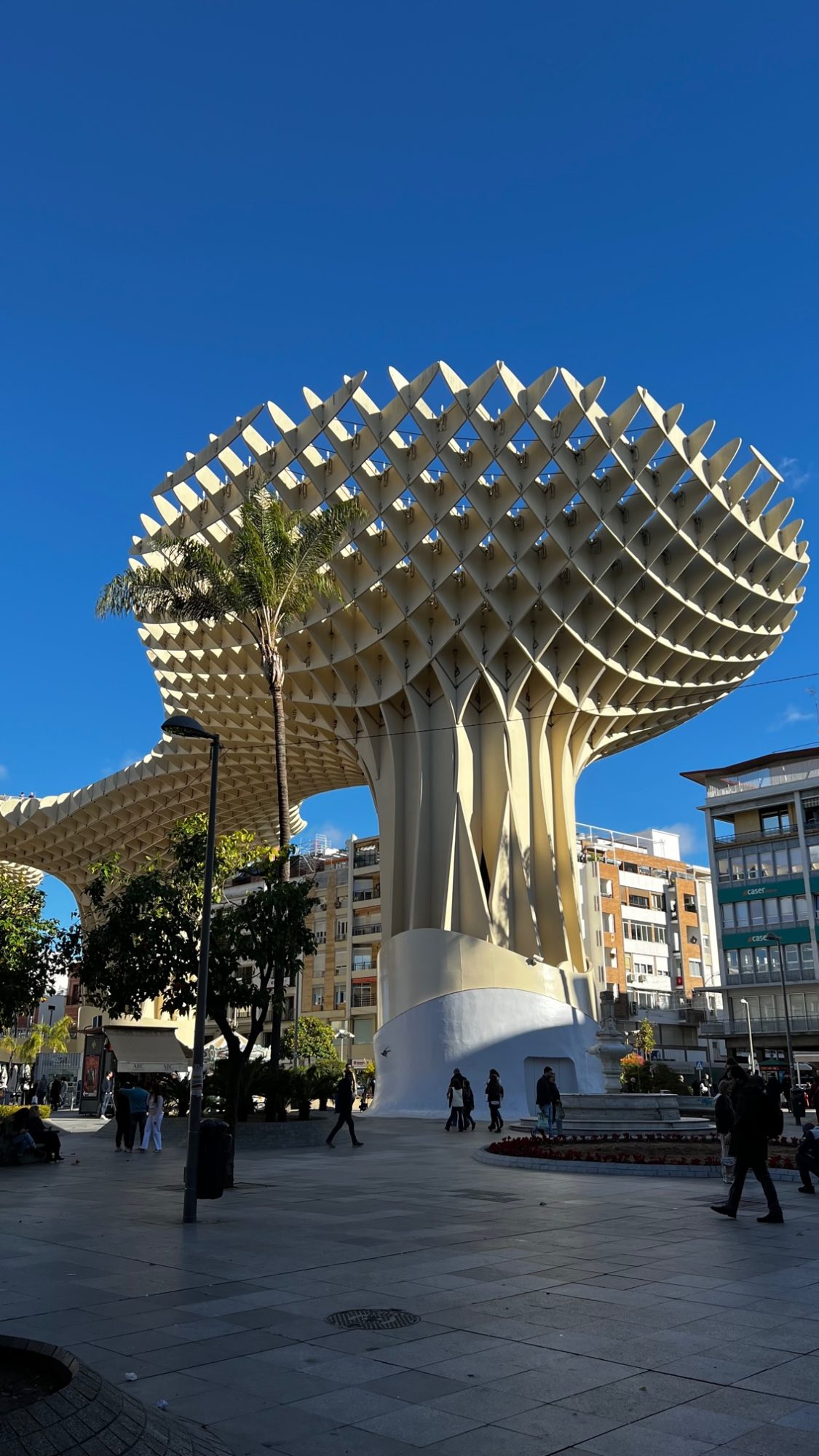
The Metropol Parasol, affectionately known as Las Setas de la Encarnación (The Mushroom), stands as a colossal wooden creation conceived by the German architect Jürgen Mayer. This architectural marvel, resembling giant mushrooms, is a bit of a Marmite attraction in Seville – you’ll either love it or find it polarizing. Remarkably, Las Setas boasts the title of being the largest wooden structure globally.
A fascinating twist to your visit is the unexpected discovery during the Metropol Parasol’s construction – a treasure trove of ruins dating back to Roman times. Moreover, make sure to return in the evening when the Metropol Parasol transforms into an enchanting spectacle with the Asia light show. The best part? Your ticket is valid for 48 hours, allowing you to savor both the daytime panoramic views and the mesmerizing evening experience. In my opinion here you will enjoy the best views of Seville.
Definitely book tickets online.
Seville itinerary – Day 3
Tapas Tour
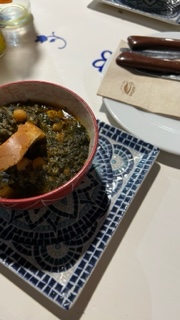

Exploring food with a local guide is the ultimate way to uncover a city’s true character, and in Seville, a tapas tour is a non-negotiable must! As a tourist, it’s easy to fall into the tourist trap, but a local guide ensures an authentic experience, leading you to hidden gems and sharing the rich stories behind each dish.
We booked an “Ugly Food Tour” with Local Food Experiences. And it was a great way to learn more about the history of Seville, it’s food culture and taste delicious flavours. It’s fantastic that locals possess a knowledge of the culinary landscape of their city, leading you to those tucked-away spots brimming with authenticity.
We visited 2 different tapas bars in Triana and tried dishes like
- Espinacas con Garbanzos: A simple yet delicious dish, it consists of spinach and chickpeas cooked with garlic and spices, showcasing the influence of Moorish flavors. My favourite by the way!
- Youate Sangre Encebollada is a tapa made with caramelized onions, oil, garlic, salt, bay leaves, sweet paprika and coagulated pig’s blood
- Pisto: Pisto is a Spanish ratatouille made with tomatoes, peppers, onions, zucchini, and sometimes eggplant. It’s often seasoned with olive oil and may include eggs poached directly in the mixture, similar to Shakshuka.
- Squid with Green Sauce on it (garlic, oil and parsley)
- Punta de solomillo, pork tenderloin with sea salt.
And some more!
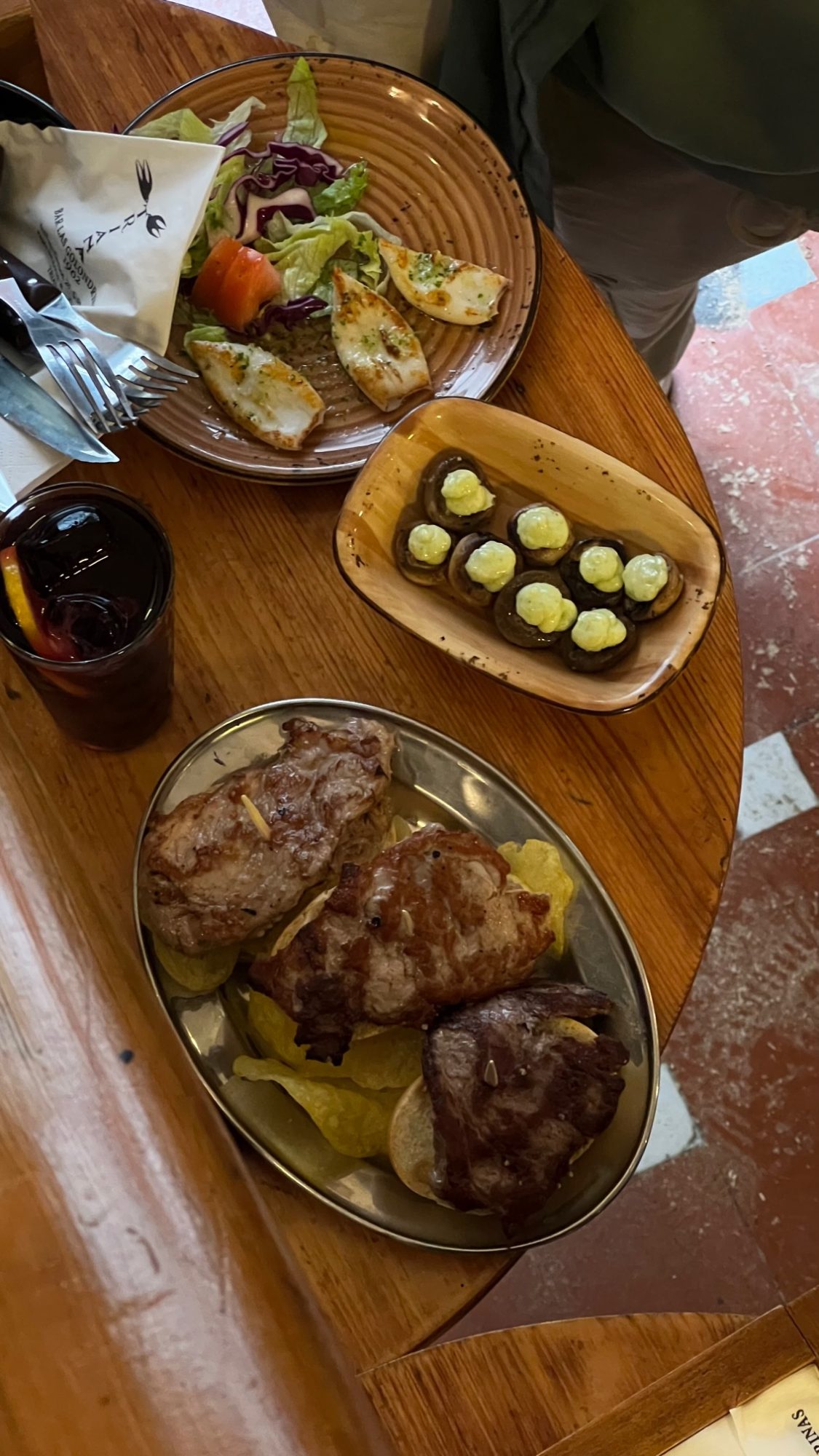
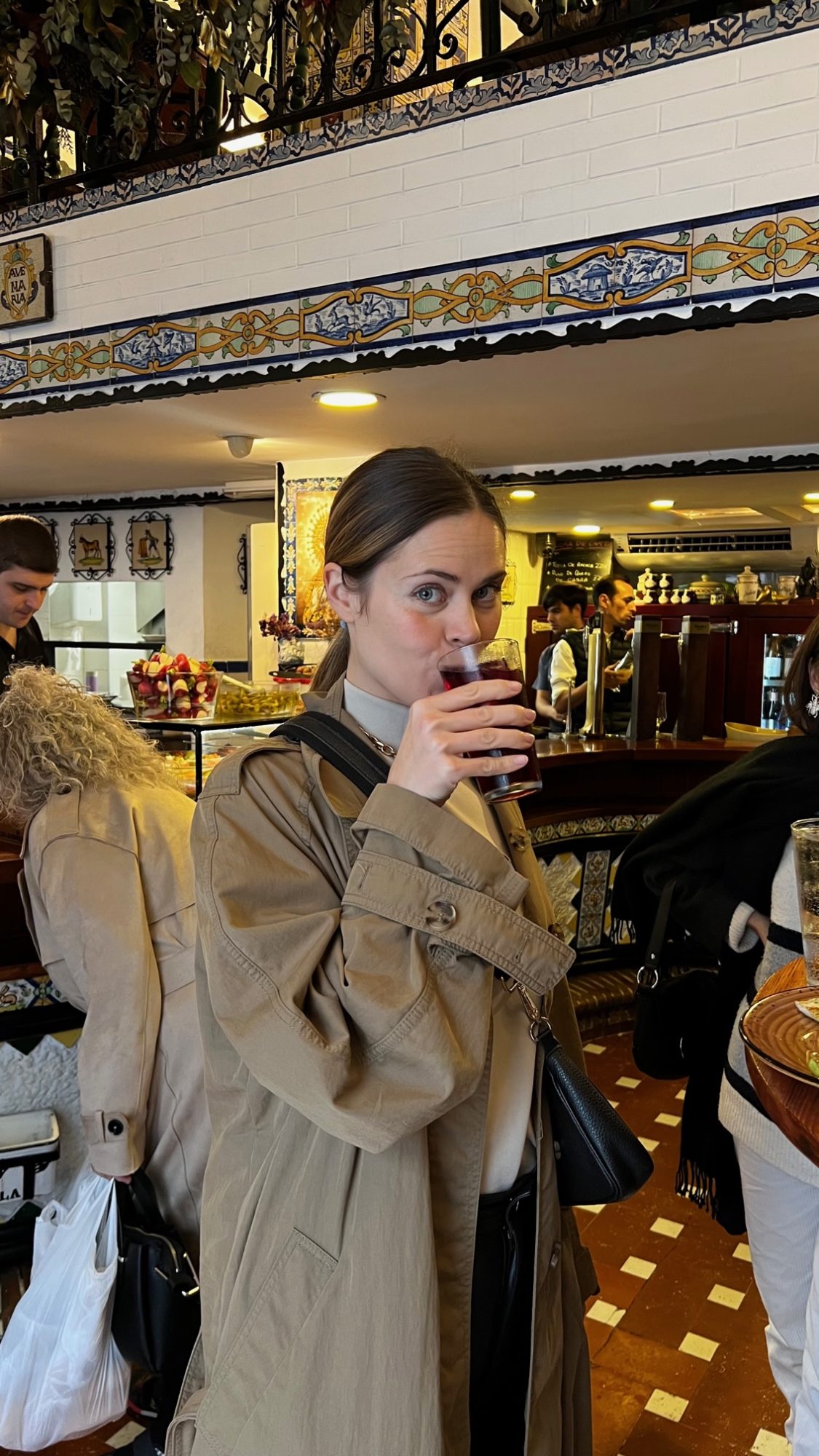
Discovering those hidden gems in Seville’s tapas scene truly added a special touch to our culinary adventure. It’s like unraveling a secret world of flavors that often avoids the typical tourist path. It’s great to stumble upon authentic, tucked-away tapas bars, offering a taste of Seville that goes beyond the mainstream!
Moreover, receiving insider tips from locals enhances the entire experience. Those recommendations serve as a guide to the city’s culinary treasures!
Torre del Oro
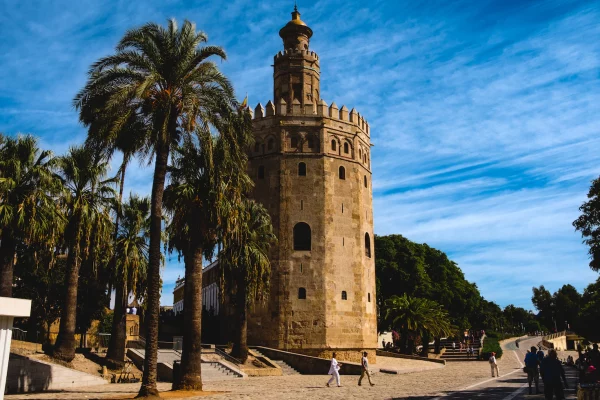
The Torre del Oro, or the Gold Tower, stands as a relic from Seville’s Islamic past, tracing its origins back to the 13th century. Initially part of a pair of watchtowers guarding the city’s entrance, it is the sole surviving tower from that era and an integral segment of the historical city walls.
Enduring various renovations over the centuries, the tower faced substantial damage after the Lisbon Earthquake of 1755, whose shockwaves reverberated to Seville. Within the Torre del Oro, the lower floor encapsulates the history of the tower and its role in defending Seville, while the second floor hosts a modest nautical museum.
The tower’s allure lies in its panoramic views from the top, offering a breathtaking perspective of the Guadalquivir River and the Old Town. Gazing across to Triana on the opposite bank, your next destination, grants a unique vantage point. Additionally, the tower provides a captivating view of the colossal Seville Cathedral, a dominating presence over the Old Town that becomes strikingly evident from this elevated perch.
Tip: want to save some money? There is no admission fee to visit the Torre del Oro on Monday.
Flamenco Show at Casa de la Memoria
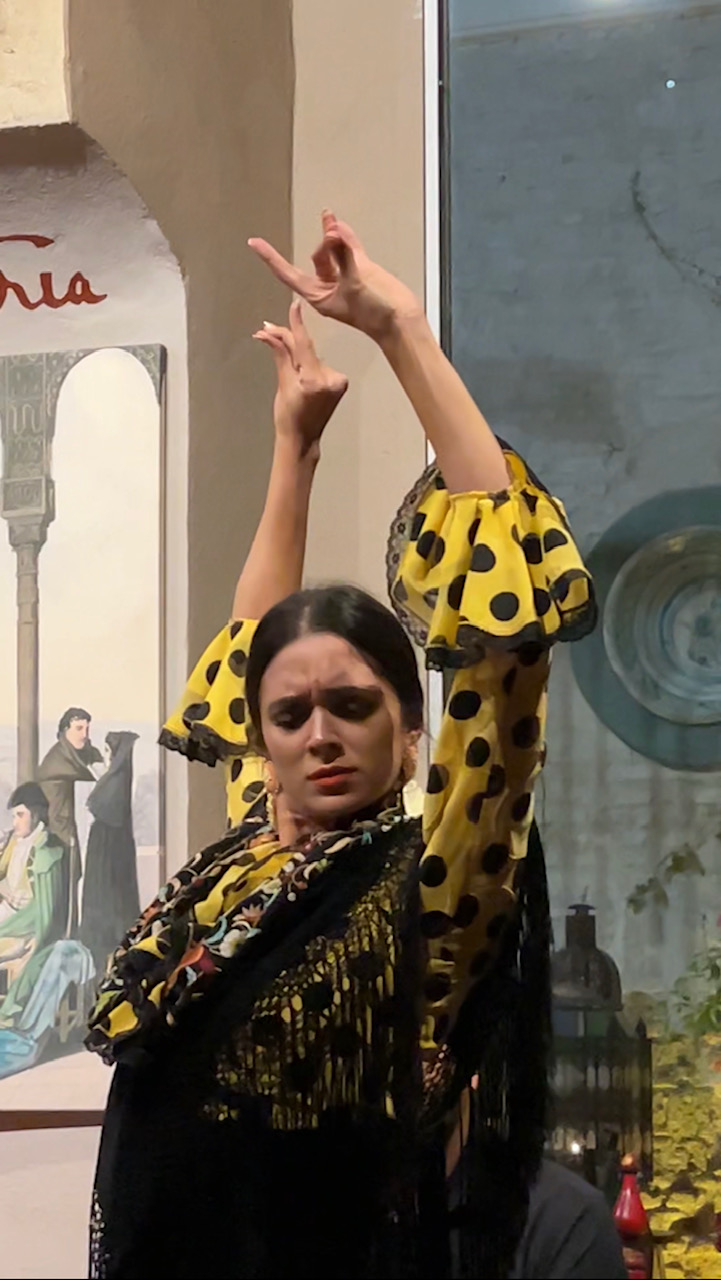
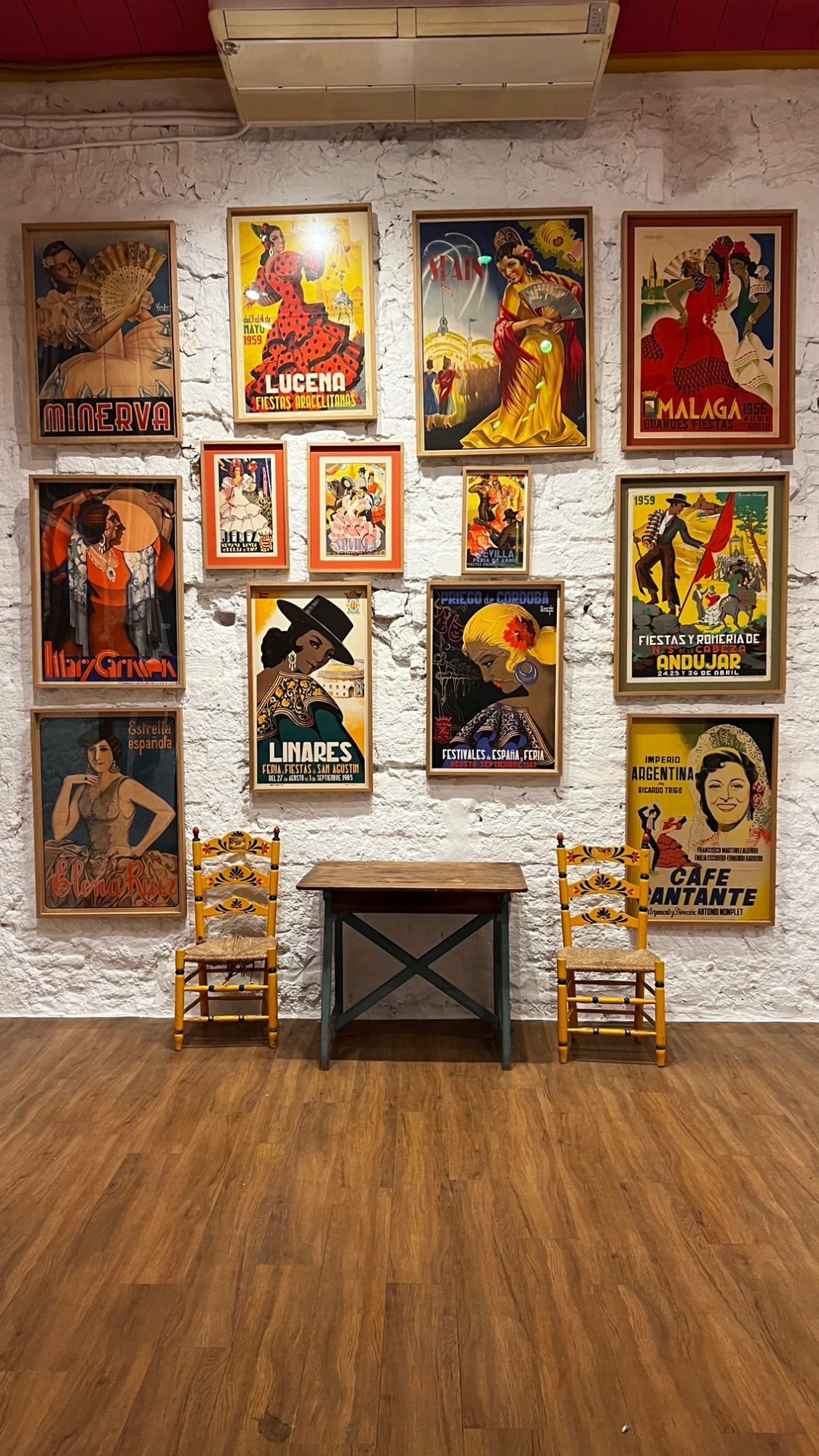
Located in a historic building at the heart of Seville, Casa de la Memoria stands as a Flamenco Cultural Center. Housed in a historic building with a rich past, it’s like stepping into a sixteenth-century storybook where the old stable has transformed into a captivating stage for the mesmerizing Flamenco show. We came to enjoy the famous flamenco spectacle known as “Tarde de Flamenco”. We stepped into the beautiful theatre, offering a captivating view of the central courtyard. The light in the room with chairs and small stage was dimmed creating intimate atmosphere.
Running for about an hour, the “Tarde de Flamenco” at Casa de la Memoria features an outstanding ensemble, including a female dancer (bailaora), a male dancer (bailaor), two singers (cantaor), and a guitarist. The experience is unforgettable and actually hard to describe since it’s all about the emotions. After the show I found out that the Center’s stage has witnessed performances by renowned national artists, including Pastora Galván, recipient of the National Flamenco Dance Award, along with Asunción Pérez “Choni,” Maribel Ramos, and many more.
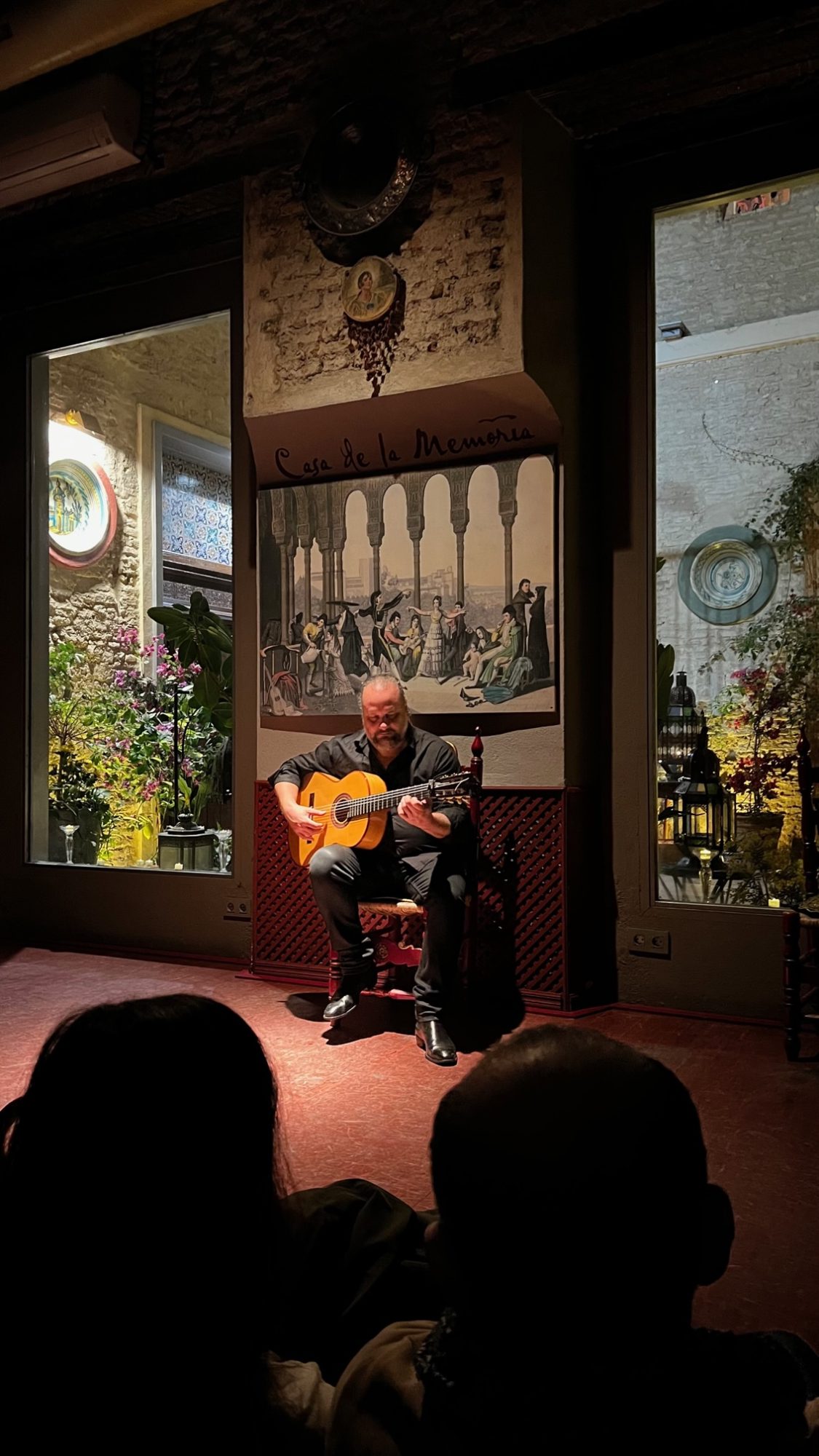
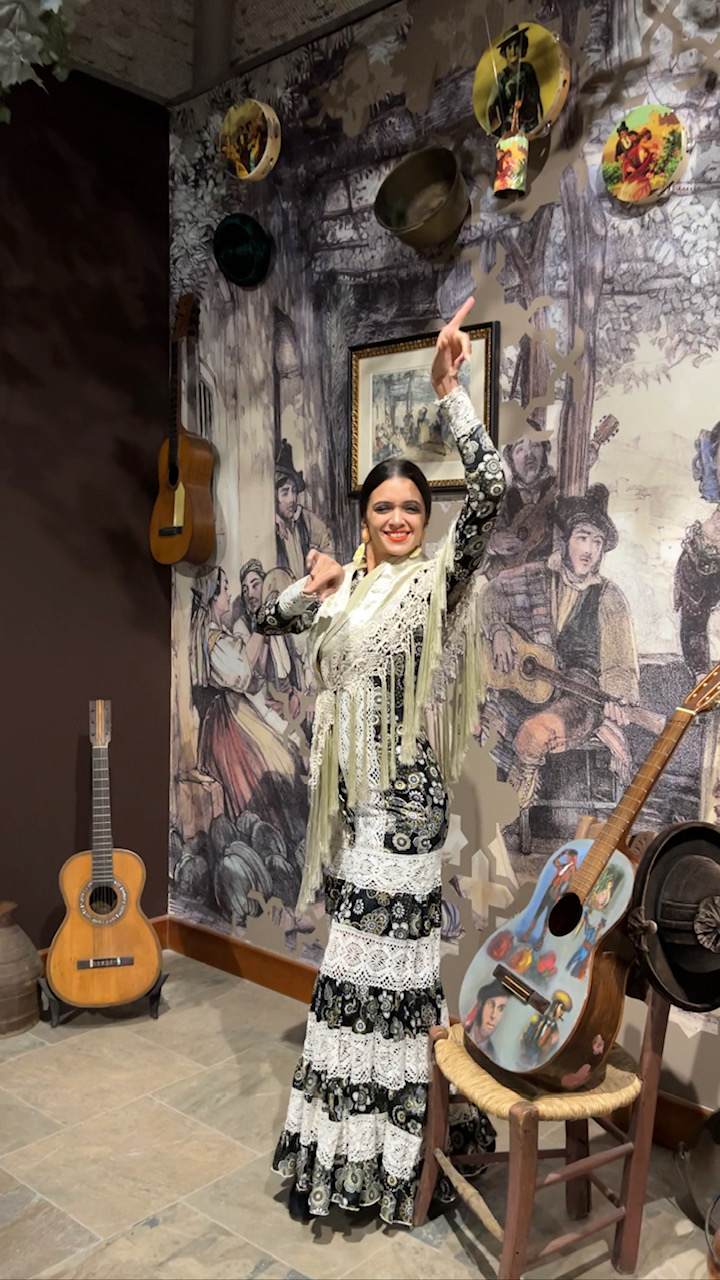
But Casa de la Memoria isn’t just about the show since it’s also a Flamenco Cultural Center. Beyond the enthralling performance, we could immerse ourselves in flamenco exhibitions within the museum housed in the same building. Here I’ve learned that Flamenco is a complex and dynamic art form. It’s foundations are deeply connected to the musical and dance traditions of Andalusian Gypsies (Romani), the art form also bears the imprint of Moorish, Jewish, and Castilian folk elements.
And for those looking to take a piece of the experience home, there’s a delightful store offering flamenco-themed souvenirs.
Seville itinerary – Day 4
Triana
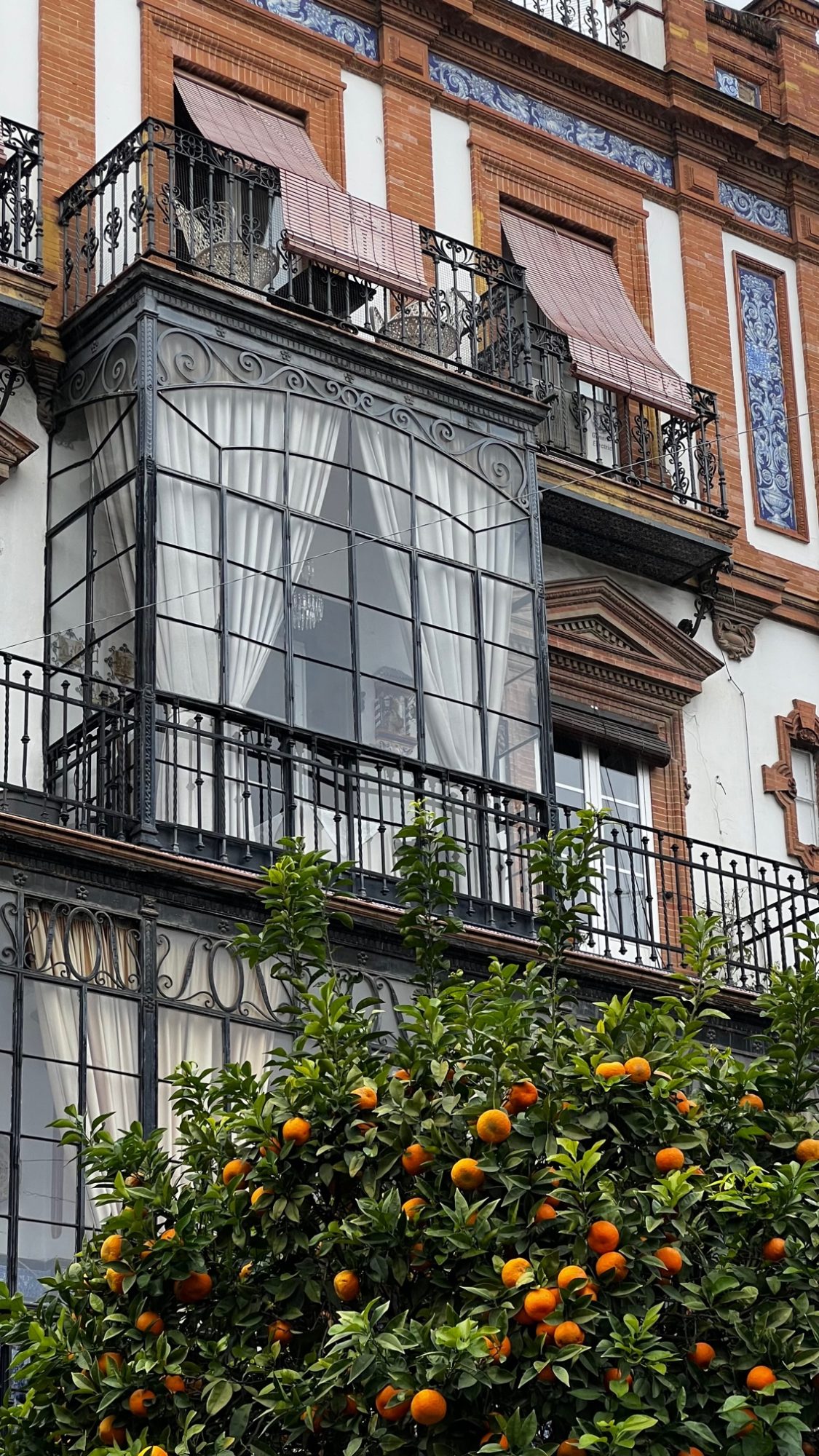
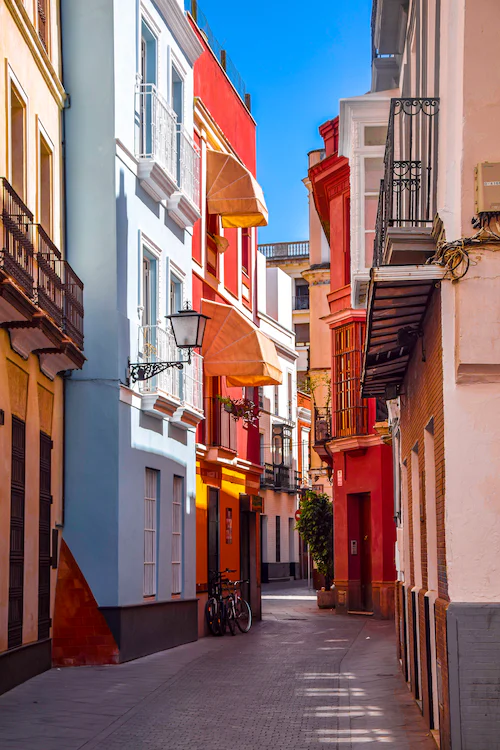
As you proceed with your 4-day itinerary in Seville, the next destination awaits across the Guadalquivir River in the picturesque neighborhood of Triana. To reach this enchanting area, simply traverse the Puente Isabel II bridge.
Seville is famous for it’S beautiful intricate and vibrant azulejo tiles, and in Triana, you’ll discover their origins. This charming and peaceful district offers a more residential ambiance, inviting you to leisurely wander its streets. For those intrigued by the history behind these stunning tiles, a visit to Triana is a must.
AIRE Ancient baths
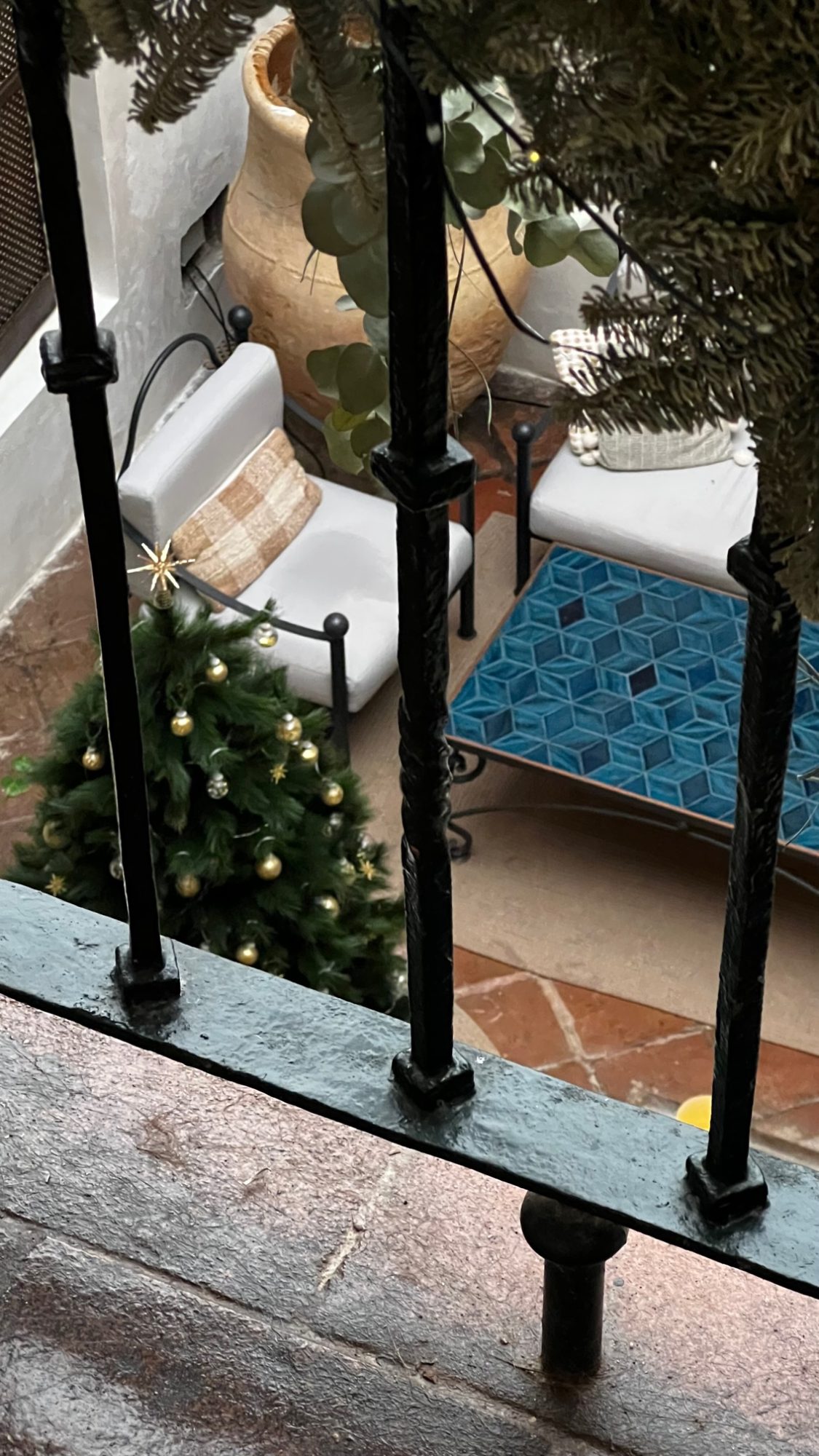
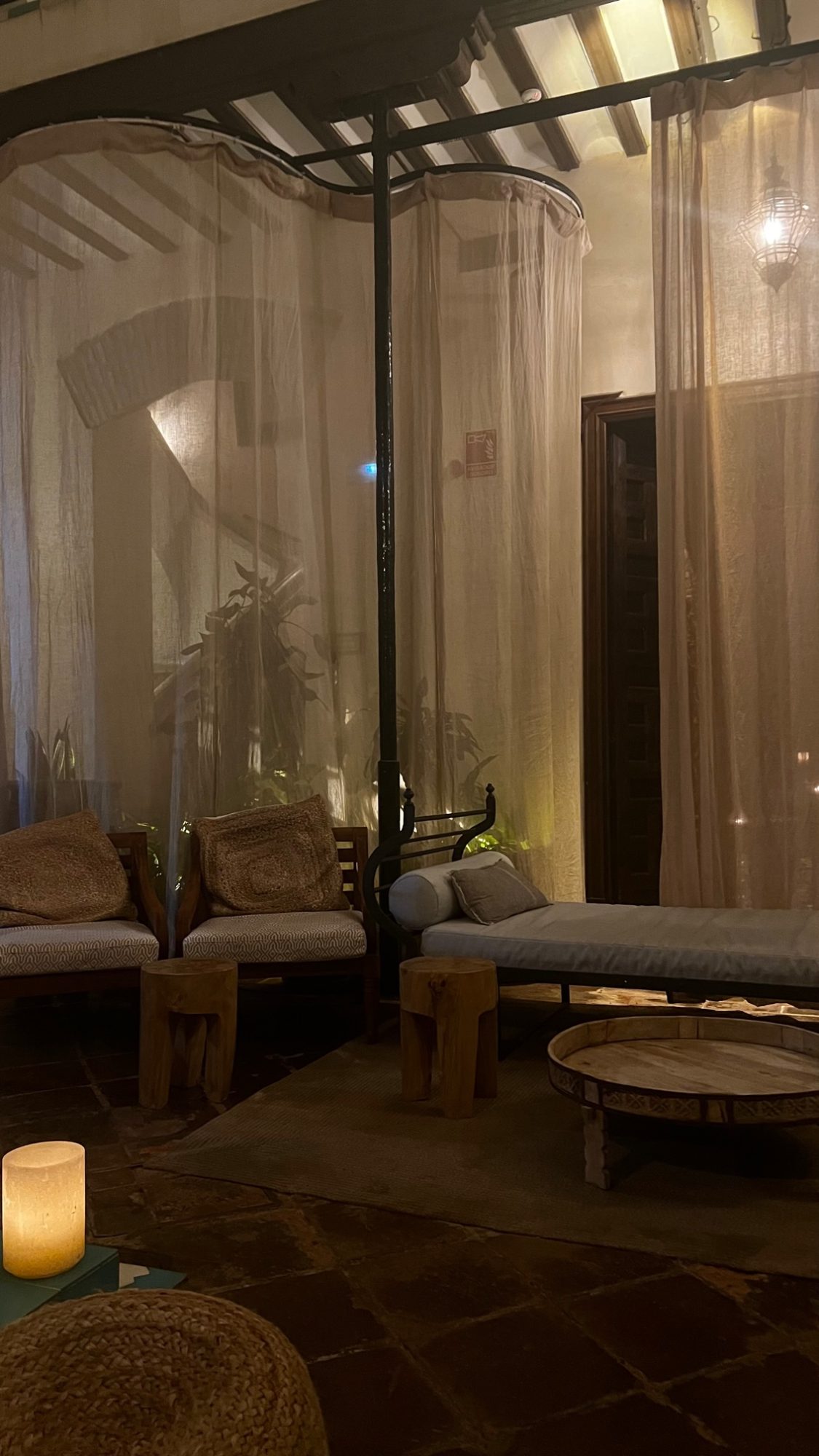
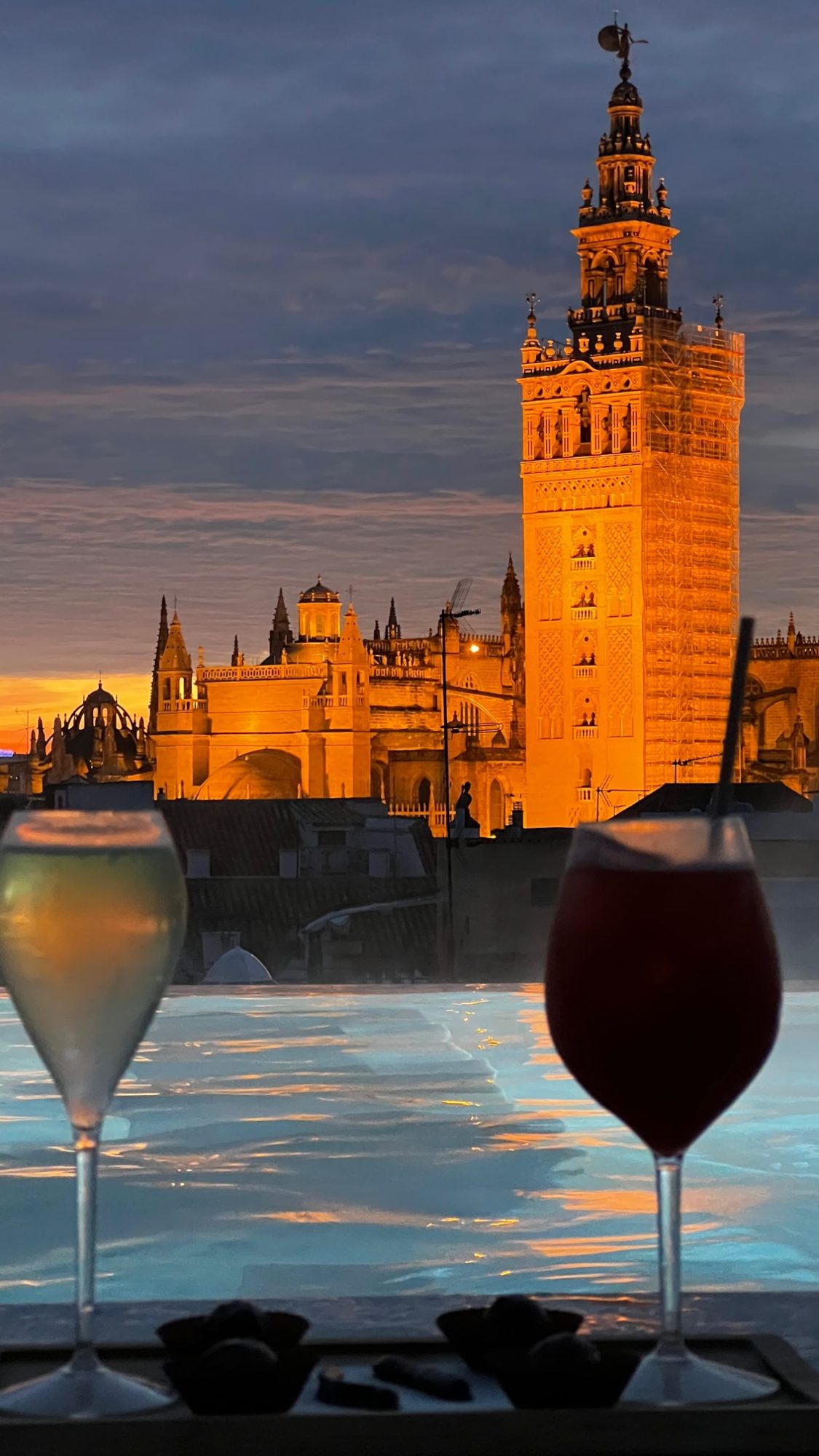
If you are in Seville than definitely treat yourself and book 2 hours of relaxation at AIRE Ancient Baths. My personal experience was nothing short of magical. From the moment I stepped into this sanctuary of tranquility, I was transported to a world where time seemed to slow down. The dimly lit thermal baths, inspired by ancient civilizations, offered a serene escape from the hustle and bustle of everyday life. Each bath, with its unique temperature and properties, embraced me in a cocoon of relaxation.
After indulging in the therapeutic waters, I treated myself to a massage that was one of the best that I’ve ever had! The skilled therapist tailored the experience to my preferences, melting away tension and leaving me in a state of utter bliss.
The crowning jewel of the experience was the rooftop bath with bubble (strawberry juice for me) and chocolate truffles. Important to mention the the panoramic view of Seville, with the iconic Giralda Tower! I definitely felt a sense of luxury and tranquility.
AIRE Ancient Baths had truly curated an experience that lingered in my memory as a perfect blend of relaxation, indulgence, and the charm of Seville’s skyline. It’s also a perfect way to spend some quality time with your beloved one. This is what I did!
A (very) brief history of Seville
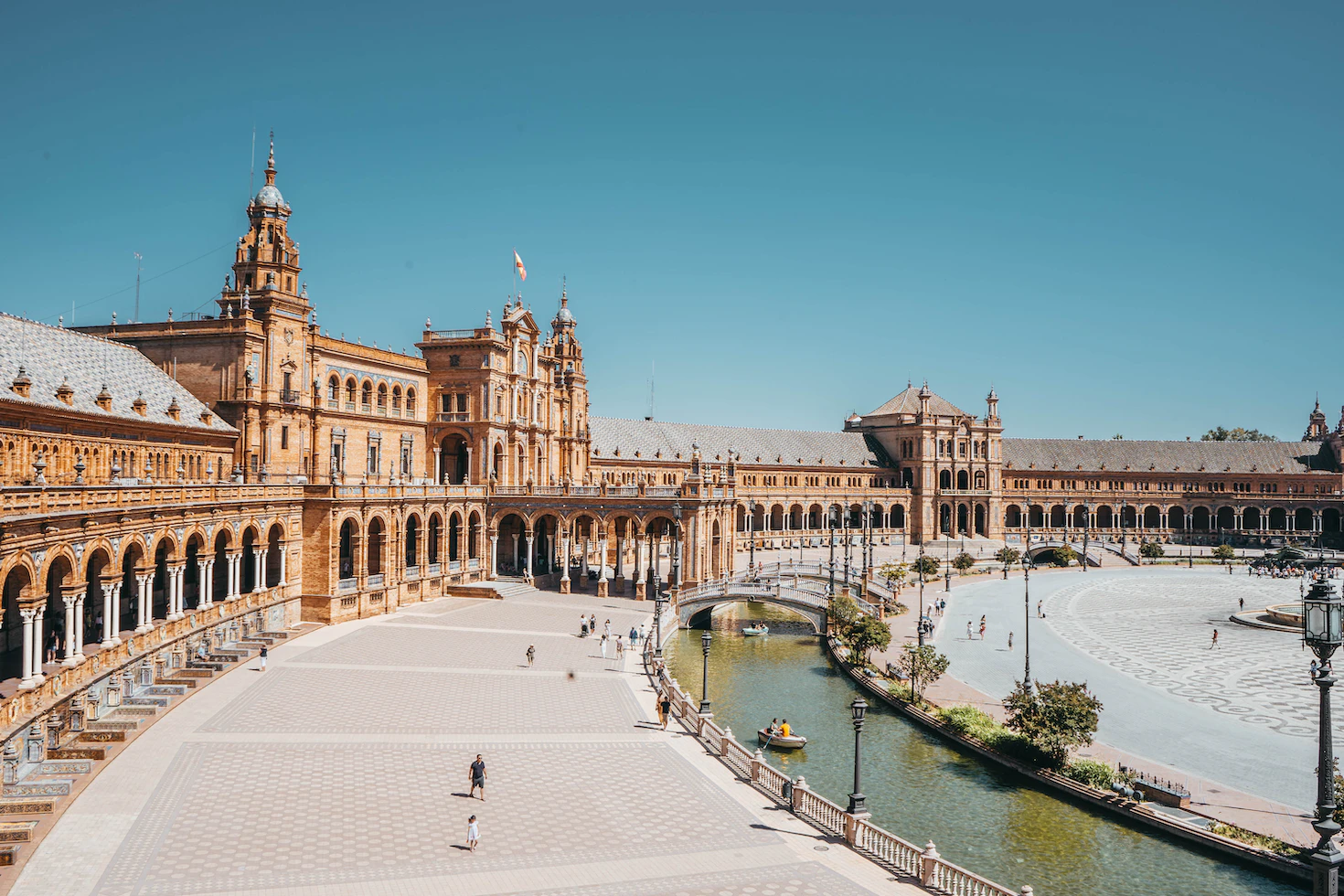
Seville, the capital of the Andalusia region in southern Spain, boasts a rich history that spans over two millennia. Founded as the Roman city of Hispalis in the 1st century BC, it later thrived under Visigothic rule. However, it was the Moors who left an indelible mark during their nearly 500-year reign, transforming Seville into a center of learning, culture, and commerce. The iconic Giralda Tower, originally a minaret, remains a testament to this era.
In 1248, Seville was reconquered by Ferdinand III of Castile, marking the Christian era. The subsequent centuries saw the city flourish as a maritime powerhouse during the Age of Discovery, thanks to its river port. Seville became a gateway to the New World, and the archives of the Indies still house documents from that influential period.
The Golden Age of Seville’s cultural and artistic prominence unfolded in the 16th and 17th centuries. Renowned painters like Diego Velázquez and writers like Miguel de Cervantes were part of this flourishing period. The construction of the grandiose Cathedral of Saint Mary of the See (Seville Cathedral) began in the 15th century, incorporating the previously mentioned Giralda Tower.
Seville faced economic decline in the 18th century but saw a revival in the 19th century with the arrival of industry and the establishment of the tobacco factory, famously depicted in Bizet’s opera “Carmen.” In the 20th century, Seville underwent modernization, hosting the 1929 Ibero-American Exposition and becoming a vibrant cultural hub.
Today, Seville is celebrated for its historical treasures, lively festivals like Semana Santa and Feria de Abril, and its enchanting blend of Moorish, Gothic, Renaissance, and Baroque architecture. The city stands as a testament to the layers of history that have shaped its character, making it a captivating destination for visitors from around the world.

